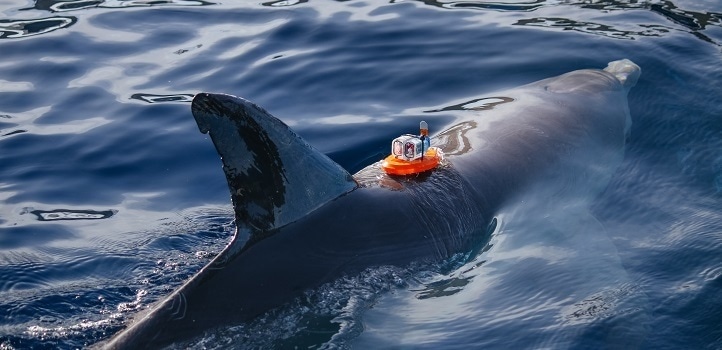Feb 5 2019
A multidisciplinary team based at KAUST has created a lightweight, flexible, and robust salinity sensor that can be secured to aquatic animals to enable their habitat to be monitored for a long term.
 The salinity sensor was integrated with an ultralow-power aquatic tag and attached to a bottlenose dolphin. This image was taken at the 2018 workshop “Ocean 2.0: Exploring with Marine Animals” in Valencia, Spain. (Image credit: © 2018 Robert Romosan)
The salinity sensor was integrated with an ultralow-power aquatic tag and attached to a bottlenose dolphin. This image was taken at the 2018 workshop “Ocean 2.0: Exploring with Marine Animals” in Valencia, Spain. (Image credit: © 2018 Robert Romosan)
The researchers developed a sensor with the ability to accurately record salinity even if it is submerged in seawater for a long term. According to the researchers, the sensor could become the basis of a marine animal monitoring device with the ability to record a number of underwater habitat parameters.
KAUST is located on the shores of the Red Sea, with a research focus on this economically important and ecologically rich ecosystem. Jürgen Kosel, an electrical engineer from KAUST, is collaborating with Carlos Duarte, a marine scientist from the Red Sea Research Center, to create monitoring devices as part of KAUST’s Sensor Initiative.
As engineers, our group aspires to furnish the marine research scientists with new technologies tailored to their needs.
Jürgen Kosel, Electrical Engineer, KAUST
One significant parameter is shifting ocean salinity, which could have an adverse effect on the health of marine organisms, as well as influence important aspects of the ocean system, for instance, water circulation. “It is a pivotal parameter used to study properties of the oceans as well as the effects of climate change,” stated Altynay Kaidarova, a PhD student in Kosel’s team.
The salinity of the water is directly proportional to its electrical conductivity, which can be measured with the help of a pair of electrodes. The difficulty faced is that, in seawater, microorganisms start flourishing on the electrode surface, leading to a decrease in the recorded conductance values. Kosel and his colleagues have created a sensor that solves this issue.
The researchers used a flexible polymer sheet to develop the sensor. The team wrote on the sheet with the help of a laser beam to heat targeted strips of the polymer, disintegrating the polymer structure to make conductive strips of graphene forming the electrodes. Upon being operated at low frequency, biofouling led to the same drop in conductance that had affected earlier devices. However, upon being operated at high frequency, the researchers demonstrated that biofouling had no effect on the performance and the sensor preserved a steady reading even after being submerged in seawater for weeks together.
We avoided the influence of foulants’ recruitment on the surface of the electrodes, which is expected to solve longterm reliability issues.
Altynay Kaidarova, PhD Student, KAUST
The researchers intend to use the laser-induced graphene method as an all-around, low-cost means to develop integrated sensor platforms with the ability to monitor salinity, temperature, pH, pressure, and magnetic field. “The data collected from these versatile sensors are intended to be incorporated into Red Sea conservation management,” stated Kaidarova.